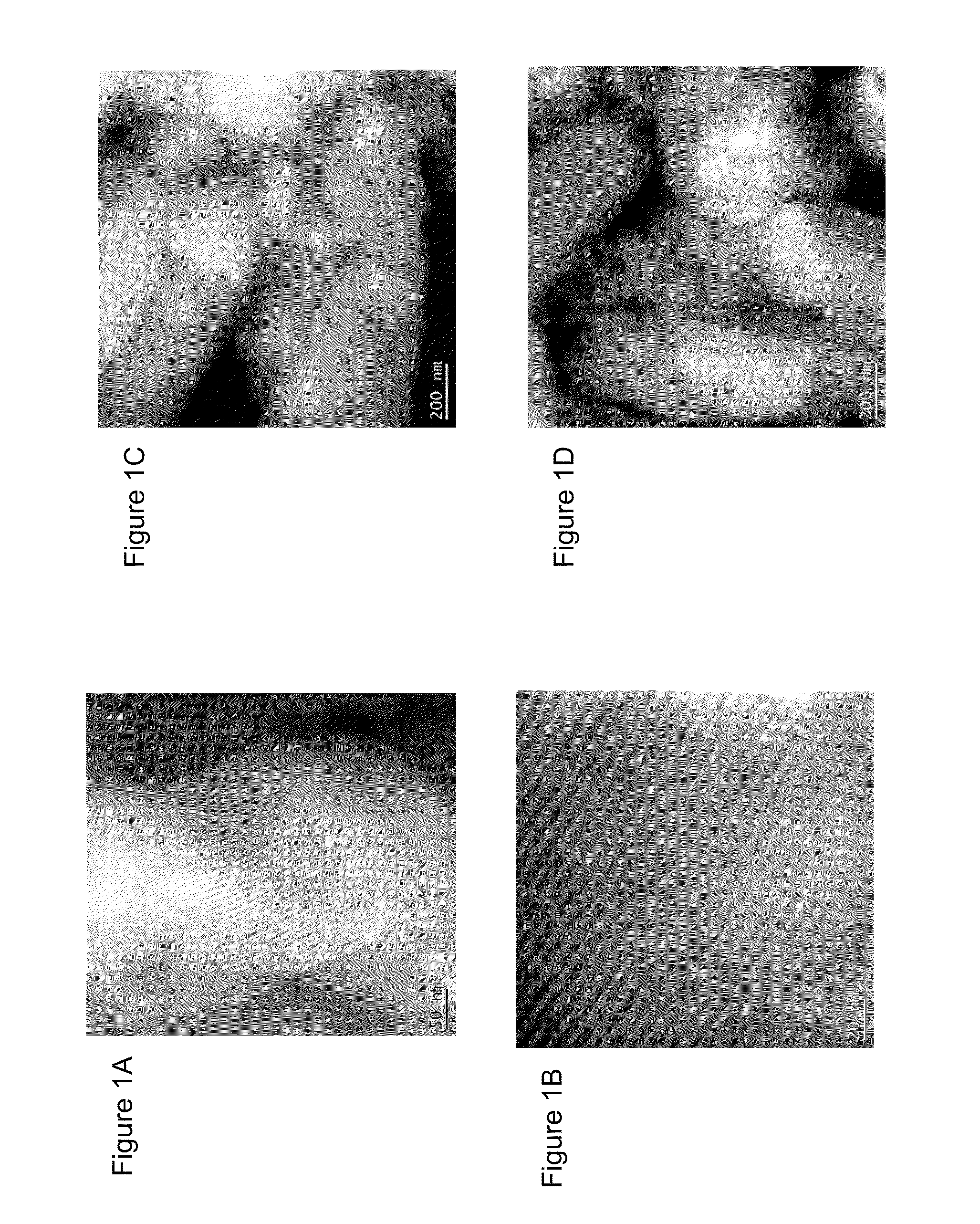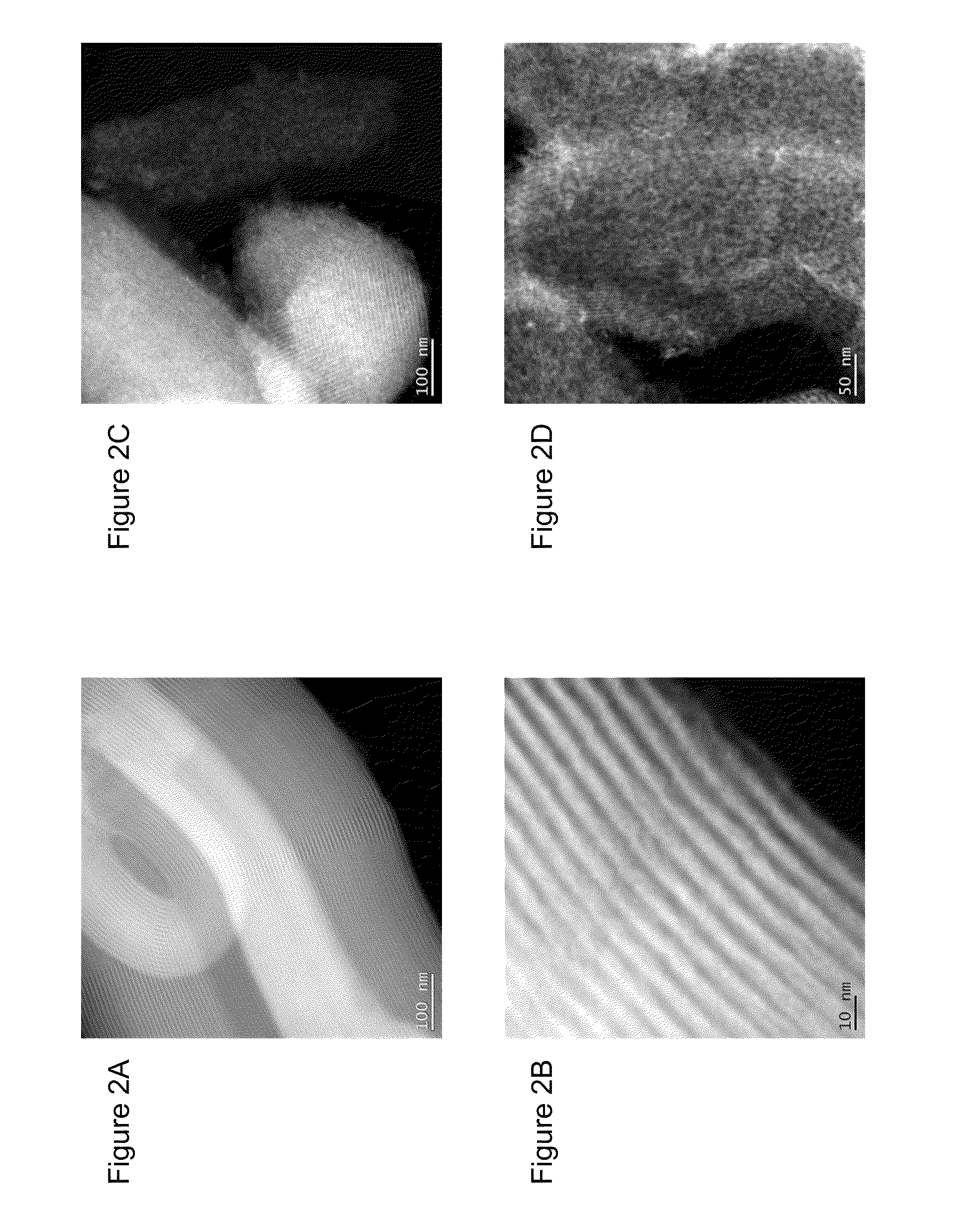Hydrothermal performance of catalyst supports
a technology of catalyst supports and hydrothermal performance, which is applied in the direction of catalyst activation/preparation, metal/metal-oxide/metal-hydroxide catalysts, physical/chemical process catalysts, etc., can solve the problems of reducing catalytic activity, affecting the stability of catalysts, so as to improve the structural performance of catalyst supports and improve long-term catalytic performan
- Summary
- Abstract
- Description
- Claims
- Application Information
AI Technical Summary
Benefits of technology
Problems solved by technology
Method used
Image
Examples
example 1
[0034]Hydrothermal Stability Study of uncoated SBA-15.
[0035]The hydrothermal stability of uncoated SBA-15 was evaluated. The SBA-15 support substrate had a surface area of 959 m2 / gram, a pore diameter of 5.9 nm (as obtained from BJH of the adsorption isotherms), and a pore volume of 1.117 cm3 / gram. FIGS. 1A and 1B show STEM images of the SBA-15 support substrate. The depicted support substrate exhibits hexagonally ordered mesopores that have a wall thickness of from about 4 nm to about 6 nm.
[0036]A portion of the SBA-15 sample support substrate was exposed to a first hydrothermal condition of 403 K, 400 psi Ar in H2O. Following exposure to first hydrothermal condition, the sample had a surface area of 470 m2 / gram, a pore diameter of 8.8 nm, and a pore volume of 1.016 cm3 / gram. Another portion of the SBA-15 support substrate samples was exposed to a second hydrothermal condition of 473 K, 400 psi Ar in H2O. Following exposure to the second hydrothermal condition, the sample had a sur...
example 2
[0037]Hydrothermal Stability Study of SBA-15-ALD-1C-Nb2O5.
[0038]A catalytic support system comprising the SBA-15 support substrate described in Example 1 was prepared with a coating of niobium oxide using ALD. The catalytic system was prepared by heating the substrate to 200° C. in air for 30 minutes. Next the substrate was placed into the ALD reactor and heated to 200° C. under 1.2 Torr of ultrahigh purity nitrogen at a mass flow rate of 200 sccm for 10 minutes. The substrate underwent a single ALD cycle. The ALD cycle included exposure of the substrate to a niobium pentethoxide precursor for 480 seconds at a partial pressure of 1-2 mTorr. The substrate was purged with nitrogen for 240 seconds, which was followed by an exposure of the substrate to water vapor for 480 seconds at a partial pressure of 20 mTorr, and then the substrate was purged again with nitrogen for 240 seconds. The resulting conformally coated catalyst system had a niobium oxide loading of about 8 wt %, a surface ...
example 3
[0040]Hydrothermal Stability Study of SBA-15-ALD-4C-Nb2O5.
[0041]A catalytic support system comprising the SBA-15 support substrate described in Example 1 was prepared with a coating of niobium oxide using four ALD cycles using the ALD cycle described in Example 2. The resulting catalyst system had a niobium oxide loading of about 28 wt %, a surface area of 351 m2 / gram, a pore diameter of 5.7 nm, and a pore volume of 0.626 cm3 / gram. FIGS. 3A and 3B show STEM images of the coated sample.
[0042]The catalyst support system was evaluated under the first hydrothermal condition. Following exposure to the first hydrothermal condition, a first set of samples had a surface area of 415 m2 / gram, a pore diameter of 6.3 nm, and a pore volume of 0.685 cm3 / gram. A second set of coated support substrate samples was exposed to the second hydrothermal condition. Following the second exposure, the second samples had a surface area of 351 m2 / gram, a pore diameter of 7.4 nm, and a pore volume of 0.638 cm3...
PUM
| Property | Measurement | Unit |
|---|---|---|
| thickness | aaaaa | aaaaa |
| thickness | aaaaa | aaaaa |
| temperatures | aaaaa | aaaaa |
Abstract
Description
Claims
Application Information
 Login to View More
Login to View More - R&D
- Intellectual Property
- Life Sciences
- Materials
- Tech Scout
- Unparalleled Data Quality
- Higher Quality Content
- 60% Fewer Hallucinations
Browse by: Latest US Patents, China's latest patents, Technical Efficacy Thesaurus, Application Domain, Technology Topic, Popular Technical Reports.
© 2025 PatSnap. All rights reserved.Legal|Privacy policy|Modern Slavery Act Transparency Statement|Sitemap|About US| Contact US: help@patsnap.com



